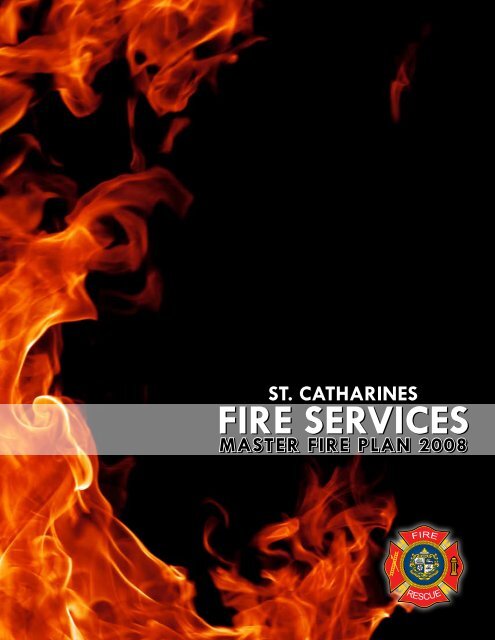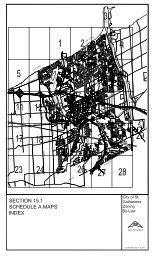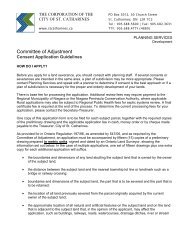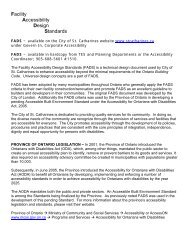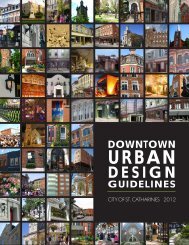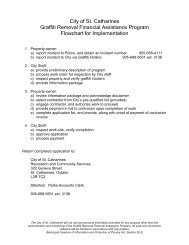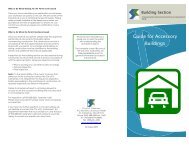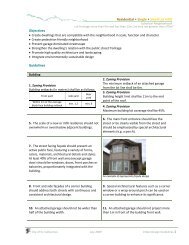2008 Fire Master Plan - City of St. Catharines
2008 Fire Master Plan - City of St. Catharines
2008 Fire Master Plan - City of St. Catharines
You also want an ePaper? Increase the reach of your titles
YUMPU automatically turns print PDFs into web optimized ePapers that Google loves.
ST. CATHARINESFIRERESCUEMission <strong>St</strong>atement:To serve and protect the citizens <strong>of</strong> <strong>St</strong> <strong>Catharines</strong> from the ravages <strong>of</strong> fire, to preventtheir property from becoming less valuable, and to allow for a continued quality <strong>of</strong> lifethrough a knowledge <strong>of</strong> fire safety.
1.0IntroductionFIRERESCUEST. CATHARINESFIRE SERVICESMASTER FIRE PLAN <strong>2008</strong>
FIRE1.0RESCUEIntroduction1.0 In t ro d u c t i o nBy initiating a <strong>Master</strong> <strong>Fire</strong> <strong>Plan</strong> the <strong>City</strong> <strong>of</strong> <strong>St</strong> <strong>Catharines</strong> seeks to strategically guide the <strong>St</strong> <strong>Catharines</strong><strong>Fire</strong> Services through the next 5 years <strong>of</strong> Municipal growth. The <strong>Master</strong> <strong>Fire</strong> <strong>Plan</strong> included a review <strong>of</strong>all aspects <strong>of</strong> the department in order to ensure that performance standards and guidelines reflect bestpractices and are in compliance with the Ontario <strong>Fire</strong> Protection and Prevention Act 1997 (FPPA) andthe Office <strong>of</strong> the Ontario <strong>Fire</strong> Marshal.The goal <strong>of</strong> this report is to gain a clear understanding <strong>of</strong> the <strong>Fire</strong> Service’s existing and future requirementsby setting key objectives and performance measures. The purpose <strong>of</strong> this report is to make recommendationsbased on current industry standards as well as accounting for future estimated needs. The <strong>St</strong> <strong>Catharines</strong> <strong>Master</strong> <strong>Fire</strong><strong>Plan</strong> includes an assessment <strong>of</strong> the following:• Administration;• <strong>Fire</strong> Prevention and Public Education;• Communication;• Training;• <strong>Fire</strong> Suppression;• Infrastructure, Vehicles, and Equipment;• Financial Implications;<strong>St</strong> <strong>Catharines</strong> <strong>Fire</strong> Services played a key role in this study, providing relevant data, reports andother background information. The <strong>St</strong>eering Committee also provided direction and insight atcritical points in the study. Members included:• Councilor Bill Phillips, Committee Chairman;• Councilor Jeff Burch;• Councilor Greg Washuta;• Colin Briggs, CAO;• Mark Mehlenbacher, <strong>Fire</strong> Chief;• Ed Lajoie, Assistant <strong>Fire</strong> Chief Support Services;• Daryl Whiteley, Assistant <strong>Fire</strong> Chief Operations;• Terry Colburn, <strong>St</strong> <strong>Catharines</strong> <strong>Fire</strong> Services Association• Ryan Madill, <strong>St</strong> <strong>Catharines</strong> <strong>Fire</strong> Services Association;• Jeff Dick, Office <strong>of</strong> the <strong>Fire</strong> Ontario Marshal;• Rick Finnemore, Office <strong>of</strong> the Ontario <strong>Fire</strong> Marshal;This report contains the findings and recommendations presented bythe <strong>St</strong> <strong>Catharines</strong> <strong>Fire</strong> Services <strong>Master</strong> <strong>Fire</strong> <strong>Plan</strong> Committee.MASTER FIRE PLAN <strong>2008</strong> 7
2.0BackgroundFIRERESCUEST. CATHARINESFIRE SERVICESMASTER FIRE PLAN <strong>2008</strong>
FIRE2.0RESCUEBackGroundMandate: To conduct a comprehensive examination, assessment and report on every aspect <strong>of</strong> <strong>Fire</strong> Services’mandate and its ability to deliver a broad range <strong>of</strong> services prescribed by Council and legislation suchas the <strong>Fire</strong> Protection and Prevention Act, 1997 and the Occupational Health and Safety Act.2.1 Mu n i c i pa l Pro f i l eThe <strong>City</strong> <strong>of</strong> <strong>St</strong> <strong>Catharines</strong> with a population <strong>of</strong> 131,990 covers an area <strong>of</strong> 28 sq miles. <strong>St</strong> <strong>Catharines</strong> isfast becoming a Municipality that is favored by the elderly. As indicated in the table below over 18% <strong>of</strong> thepopulation is 65 and over.Ages <strong>of</strong> population 2006 2001 % <strong>of</strong> Total Population 20060-14 21,385 22,145 16 (Ontario - 20)15-64 86,780 83,760 66 (Ontario - 67)65 and over 23,830 23,265 18 (Ontario - 13)Total Population 131,995 129,170 100Being a short distance from Niagara Falls, <strong>St</strong> <strong>Catharines</strong> does have a number <strong>of</strong> hotels/motels although whencompared to other Municipalities in Niagara the number is relatively small. Based on the OFM criteria <strong>St</strong> <strong>Catharines</strong>has a total <strong>of</strong> fourteen (14) hotels/motels.There are 73 institutional occupancies, including hospitals (3), nursing homes (20) homes for special care (27) grouphomes (26) in the city. The estimated number <strong>of</strong> individuals living in these occupancies is 2,847.The senior’s population (65 and over) has increased almost 36% since 1986. The 45-54 age category percentagechange for the same time period was 39%. The 2006 Census figures confirm that more persons will be occupyingthe above type’s buildings. In the coming years our seniors population will continue to grow. This in itself presents aconcern with regards to ensuring our elderly are properly trained and informed on the hazards that they might findwithin their homes.<strong>St</strong>. <strong>Catharines</strong> also has a population fluctuation from a large influx <strong>of</strong> students attending Brock University and NiagaraCollege from September to May; approx. 18,500 students in 2005. Brock has 2,391 on campus beds in variousapartment complexes, and town housing arrangements. Off campus student housing consists <strong>of</strong> single family dwellingsconverted to accommodate 6 – 9 students, and multi family dwelling units in apartments and townhouses. These types<strong>of</strong> occupancies pose significant challenges for the <strong>Fire</strong> Service especially in the area <strong>of</strong> public education and fireprevention activities.MASTER FIRE PLAN <strong>2008</strong> 11
FIRERESCUEPORT DALHOUSIE<strong>St</strong> <strong>Catharines</strong> does have a number <strong>of</strong> areas <strong>of</strong> concerns for its <strong>Fire</strong> Services and thefollowing are those areas which include the respective concerns:Port Dalhousie has a unique situation geographically, in that there are only two ways into that section <strong>of</strong> the town.One access being the bridge on Lakeport Rd, and the other, via Martindale Rd., on the opposite end <strong>of</strong> Main <strong>St</strong>.There is also a small harbor that is home to two (2) marinas that houses an excess <strong>of</strong> 100 boats <strong>of</strong> various sizes onboth sides <strong>of</strong> the harborTraffic and crowd problems are seasonal, primarily from June to the middle <strong>of</strong> August. This is due to the warmweather attracting people to the area. This <strong>of</strong> course leads to parking problems, clogging already narrow streets <strong>of</strong>the lower older end <strong>of</strong> Port Dalhousie, including Gertrude, Simcoe, Brock, Canal and Ann <strong>St</strong>reets.Access for emergency vehicles is restricted at best when people park their vehicles in such a way on several streets,that should a fire or emergency occur, on many <strong>of</strong> these streets it would involve the staging <strong>of</strong> apparatus on the largerarteries and proceeding on foot to the fire ground.Due to the concerns <strong>of</strong> residents, businesses, and various emergency services including fire, a tighter control has beenaddressed in those areas <strong>of</strong> concern and when deemed necessary vehicles have been towed in order to provideproper access on those streets. A stronger police presence has curbed many <strong>of</strong> the issues that were arising.Identified risks include:• Increased response times to emergencies• Limited access to certain areas <strong>of</strong> Port• Possibility <strong>of</strong> panicHENLEY ISLANDHenley Island located in Port Dalhousie is home to two very large boat houses, a large parking area, an even largerpark like setting as well as a Club house on top <strong>of</strong> the island. There is one hydrant on the island near the club housenext to the parking lot.There are a number <strong>of</strong> rowing regattas that occur during the year. During these regattas the island is very busy andcrowded with rowers and rowing supporters, and for a short time period they are allowed to camp on the island.Henley Island is also a launch site for the boats used by the fire dept for rescue operations on its inland waterwaysthat covers 12 Mile Creek and Martindale pond. This covers the area from Wellandvale to Richardson Creek to thebridges and hydro generating station on Lakeport Rd. In the last 5 yrs from Jan 1, 2003 to December 31, 2007 therehave been 11 boat rescues from Henley Island.Identified risks include:• Limited water supply for fire fighting• Single way in and out• Traffic congestion during events cause increase response times12ST. CATHARINES, FIRE SERVICES
FIRERESCUE2.3 Bu i ld i n g <strong>St</strong> o c kThe city building stock is listed in the table below and the downtown core is similar to those in the Port Dalhousie andMerritton areas. Although the <strong>Fire</strong> Prevention division complies with providing complaint and request inspections forthese buildings, owners/operators rarely request inspections and complaints normally are routed through the healthand safety committee <strong>of</strong> the individual company.<strong>St</strong>atistics indicate that 27 fires were in industrial occupancies out <strong>of</strong> 427 in 2005. This translates to 6 out <strong>of</strong> every 100industrial occupancies are involved in a fire. There would be a significant impact on the workforce through lay<strong>of</strong>fs andjob loss if any <strong>of</strong> the larger facilities were shut down due to fire. These occupancies also have a higher communityimpact due to job loss and environmental concerns. The large manufacturing companies <strong>of</strong> General Motors, T.R.W.W.S. Tyler and Interlake Paper have reduced their manpower; however an interruption <strong>of</strong> any <strong>of</strong> these plants wouldaffect hundreds in the community.Oc c u pancy ListingOccupancy Classification# <strong>of</strong> OccupanciesGroup A Assembly 446Group B Institutional 73Group C Single family 40,926Multi-unit residential 1558Hotel / Motel 14Mobile Homes & Trailers 20Other 29Groups D & E Commercial 1163Group F Industrial 427Other occupancies notclassified in OBC,such as farm buildings 337Totals 45033Total # <strong>of</strong> mixed occupancy buildings 4422.4 Mu n i c i pa l Fi r e Prevention In f o r m at i o n Su rv e y (MFPIS)The <strong>St</strong> <strong>Catharines</strong> <strong>Fire</strong> Services have been successful in having completed the <strong>Fire</strong> Marshal MFPIS. This surveyis intended to assist in determining compliance with the minimum fire prevention and public education requirements<strong>of</strong> the <strong>Fire</strong> Protection and Prevention Act 1997 (FPPA). The focus is on fire prevention and public education activities.This also enables the OFM in meeting its responsibility for monitoring municipal fire protection services in Ontarioas required by the FPPA.MASTER FIRE PLAN <strong>2008</strong> 15
FIRERESCUE2.5 Tr a n s p o r tat i o nThe <strong>City</strong> <strong>of</strong> <strong>St</strong>. <strong>Catharines</strong> is divided by several transportation arteries. They are the Q.E.W. and 406 highways, theC.N.R. rail lines and the Welland Canal which is part <strong>of</strong> the <strong>St</strong>. Lawrence Seaway system. All <strong>of</strong> these are venues forthe transportation <strong>of</strong> large amounts <strong>of</strong> material including dangerous and hazardous materials on a 24 hr basis. Thefollowing is an overview <strong>of</strong> some the risks that <strong>St</strong> <strong>Catharines</strong> can be faced with in the event <strong>of</strong> an incident.The Welland Canal starts in Lake Ontario and proceeds on a southerly direction through <strong>St</strong> <strong>Catharines</strong> to end in PortColborne and Lake Erie. Incidents have occurred in the past whereby there have been collisions (WINDOC collidingwith a bridge in Port Robinson) within the seaway between ships and bridges in particular. In 2006 from March toAugust 13 the canal carried 1430 ships, 786 <strong>of</strong> them inland ships and 644 ocean ships.All <strong>of</strong> these cargo ships were carrying everything from raw materials to chemicals to fuels. As our firefighters conductlimited shipboard firefighting, the hazards and the problems that we as a <strong>Fire</strong> Service can face are enormous.The two major highways, the Q.E.W. and the 406, carry the majority <strong>of</strong> the vehicular traffic especially commercialtransport vehicles through the city boundaries and carrying a vast assortment <strong>of</strong> products.In contacting the C.N.R. we were informed that the corridor that comes through <strong>St</strong>. <strong>Catharines</strong> handles 16 to 30trains a day (upwards <strong>of</strong> 50 cars per trip) primarily <strong>of</strong> freight; however this does include two passenger trains aday between Niagara and Toronto. The other trains are mixed manifest freight trains that carry everything fromfinished automobiles, to steel, lumber, petrochemicals, grain, paper plastic pellets etc. and a number <strong>of</strong> other industrialchemicals needed in the manufacture <strong>of</strong> a host <strong>of</strong> finished products. The risk to this Municipality increases with thenumber <strong>of</strong> railroad crossings that we have (8 crossings and 4 bridges). A detailed compilation <strong>of</strong> these regulatedcommodities will be made available to us as needed. The CNR does not have any storage buildings or warehouses inour area.2.6 Org a n iz at i o n a l Ri sk sIn the next 3-5 years <strong>St</strong> <strong>Catharines</strong> <strong>Fire</strong> Services will be facing an influx <strong>of</strong> retirements <strong>of</strong> potentially over 30firefighters/fire <strong>of</strong>ficers who will be retiring and taking away a vast amount <strong>of</strong> experience. Nineteen <strong>of</strong>ficers whorepresent almost one half <strong>of</strong> the <strong>of</strong>ficer ranks will be retiring. The amount <strong>of</strong> experience that will be lost from our<strong>of</strong>ficers retiring will leave a huge void within the organization. Given the push by the Ministry <strong>of</strong> Labour to ensurewe are following proper health and safety procedures including having trained and qualified supervisors there is avery important need for a strong <strong>of</strong>ficer development program. As well the length <strong>of</strong> time it takes to go through thehiring process in addition to conducting recruit training will be a major challenge for the training division. Training thisamount <strong>of</strong> staff will be virtually impossible without added resources in both the Training and Suppression divisions.16ST. CATHARINES, FIRE SERVICES
3.0CAPABILITIES OF EXISTING FIRE PROTECTION SERVICESFIRERESCUEST. CATHARINESFIRE SERVICESMASTER FIRE PLAN <strong>2008</strong>
FIRE3.0CAPABILITIES OF EXISTING FIRE PROTECTION SERVICESRESCUE3.1 AdministrationThe <strong>St</strong> <strong>Catharines</strong> <strong>Fire</strong> Services is organized into five divisions which include administration, suppression, training,fire prevention and communications. The management and administration <strong>of</strong> the department is made up <strong>of</strong>three senior management personnel: the <strong>Fire</strong> Chief; the Assistant <strong>Fire</strong> Chief (Operations); and theAssistant <strong>Fire</strong> Chief (Support Services).The division also includes three <strong>of</strong>fice staff, the executive assistant to the <strong>Fire</strong> Chief, one full time accounts clerksecretary, and one secretary attached to the <strong>Fire</strong> Prevention Division, as shown in the organization chart below.The <strong>Fire</strong> Chief is also responsible to ensure the municipality is compliant with the Emergency Management andCivil Protection Act that outlines the minimum guidelines to achieve with respect to emergency preparedness. Onecorporate emergency planner is responsible for all <strong>of</strong> the municipality’s emergency preparedness and reportsdirectly to the <strong>Fire</strong> Chief.Mayor &Council<strong>St</strong>. <strong>Catharines</strong> <strong>Fire</strong> ServicesOrganizational <strong>St</strong>ructureEmergencyManagementCoordinator<strong>Fire</strong> ChiefExecutiveAssistantClerk TypistST. CATHARINESFIRERESCUEAssistant ChiefSupport ServicesClerk TypistAssistant ChiefOperationsCommunicationsPreventionTrainingSuppressionCommunicationsTechnician(1)CommunicationsCoordinator(1)Chief<strong>Fire</strong> PreventionOfficerChiefTraining Officer(1)Platoon 1 Platoon 2Platoon 3 Platoon 4Alarm Operators(10)Public Education/Inspector(1)Senior Inspector(1)Inspectors(5)Instructor(1)Platoon Cheif(1)Senior Captian(1)Captians(7)Platoon Cheif(1)Senior Captian(1)Captians(7)Platoon Cheif(1)Senior Captian(1)Captians(7)Platoon Cheif(1)Senior Captian(1)Captians(7)October <strong>2008</strong><strong>Fire</strong> Fighters(25)<strong>Fire</strong> Fighters(25)<strong>Fire</strong> Fighters(25)<strong>Fire</strong> Fighters(25)MASTER FIRE PLAN <strong>2008</strong> 19
4.0FIRE PREVENTION AND PUBLIC EDUCATIONFIRERESCUEST. CATHARINESFIRE SERVICESMASTER FIRE PLAN <strong>2008</strong>
FIRE4.0FIRE PREVENTION AND PUBLIC EDUCATIONRESCUE4.1 <strong>Fire</strong> PreventionThe <strong>Fire</strong> Prevention Division has one (1) Chief <strong>Fire</strong> Prevention Officer who oversees the operations <strong>of</strong> the <strong>Fire</strong>Prevention division. Under him is one (1) Senior <strong>Fire</strong> Inspector who oversees plan reviews, building permits andassist Junior <strong>Fire</strong> Inspectors out in the field. He oversees the operations within <strong>Fire</strong> Prevention in the absence <strong>of</strong>the Chief <strong>Fire</strong> Prevention Officer. The remaining staff include 6 PFST/ <strong>Fire</strong> Inspectors and one (1) clerk typist.The Province <strong>of</strong> Ontario and the Office <strong>of</strong> the <strong>Fire</strong> Marshal have recognized that <strong>Fire</strong> Prevention is essential toreducing fire death, fire injuries and fire losses in Ontario. This recognition has been translated into legislationthrough the <strong>Fire</strong> Protection and Prevention Act (FPPA) that states “Every municipality shall establish a program in themunicipality which must include public education with respect to fire safety and certain components <strong>of</strong> fire prevention”Given this mandate the fire prevention division is meeting all theprescribed requirements <strong>of</strong> the FPPA by creating and supporting:• A comprehensive public education program,• Implementing fire prevention activities through complaint, request and routine fire inspection• Conducting fire investigations.• Alarmed for Life Smoke Alarm and Public Education Program• Pre-fire <strong>Plan</strong>ning ProgramTo further enhance the prescribed requirements the fire prevention division has established the followingobjectives to ensure that we meet all our assigned responsibilities pr<strong>of</strong>iciently and accurately:• Public education• <strong>Fire</strong> code inspection,• <strong>Fire</strong> investigation• <strong>St</strong>aff roles, training and certification• Policy and Procedure guide• Integrated Electronic Data Base Tracking and Control• Other assigned dutiesThe <strong>Fire</strong> Prevention Division is also responsible for specific buildingcode duties as defined in By-Law 2005-319 that include:• <strong>Plan</strong>s review – review and approve all drawings submitted for new construction andrenovations that detail items identified under the by-law• Conduct inspections during the building process to clear all by-law relatedinstallations or renovations.• Prepare and submit to the Chief Building Official complaints and orders identifiedwhile conducting fire prevention activities.A senior member <strong>of</strong> the fire prevention division is a member <strong>of</strong> the development committee and must attendmeetings, review and approve all site plans, subdivision agreements and applications to committee <strong>of</strong> adjustment.MASTER FIRE PLAN <strong>2008</strong> 23
FIRERESCUE4.2<strong>Fire</strong> Prevention Objectives4.21 Pu b l i c Ed u c at i o nPublic education programs are being delivered on request within the community using current programs supported bythe <strong>Fire</strong> Marshals public fire safety council that target specific at risk groups. The <strong>Fire</strong> Prevention Division is currentlyreviewing our simplified risk assessment, fire response statistics from <strong>St</strong>. <strong>Catharines</strong> and Ontario to establish publiceducation programs specific to community needs.A major initiative is to undertake a partnership with all community based agencies to ensure that we are able to shareour prevention message with everyone in the community, and become a fire prevention resource for these agencies.We are currently developing a network <strong>of</strong> agencies and personnel to strengthen our approach to fire safety byintegrating our programs to follow proven prevention models and support other agencies with similar concerns.Current fire prevention education initiatives being undertaken includes:• Seniors programs – Utilize current seniors education programs as well as actionbased programs to assist seniors• Low Income Housing – site specific education programs• <strong>St</strong>udent Housing – Co-operative fire education with Brock University• Schools – Deliver a program through area inspectors to all Grade 3 students thatwill supplement the Regional <strong>Fire</strong> Safety Village.• Liaison to continue with the Food Bank• Superintendents/Property Manager Course – training for full time propertymanagers and site superintendents• Cultural – working to develop communication and training to persons that arenew to our society with language issues.• Website – Member <strong>of</strong> the fire prevention division actively participating ongoingadvances and update <strong>of</strong> the city’s website relative to fire department access toinformation and public education.• Development and Delivery <strong>of</strong> a Community <strong>Fire</strong> Safety Guide that will bedistributed to all homes in <strong>St</strong>. <strong>Catharines</strong>. Ongoing re-enforcement messagesdelivered quarterly to the household.• Alarmed for Life program to allow fire personnel to assist homeowners in achievingfire code compliance for smoke alarm installation as well as distribution <strong>of</strong> publiceducation material.• Colouring books have been developed for distribution at all public education visitsand distribution by fire crews during Alarmed for Life Program and station tours.This program will eventually have age sensitive colouring books available to alllevels in elementary schools.The process <strong>of</strong> completing a comprehensive public education program also requires a method <strong>of</strong> evaluatingour programs to ensure that the programs are successful in meeting the goal <strong>of</strong> reducing fire and life safetylosses in the community. All program activity will be tracked electronically in AMANDA to ensure that thedemographics identified in fire reports are included in our reporting to allow for the development <strong>of</strong> areport that integrates fire responses, public education initiative and other fire prevention activity toaccurately verify the benefits <strong>of</strong> the public education programs.24ST. CATHARINES, FIRE SERVICES
FIRERESCUE4.24 <strong>St</strong>a f f Ro l e s, Tr a i n i n g a n d CertificationThe current model to allocate duties to fire prevention inspectors is to assign fire response areas to eachinspector who will perform all fire prevention duties within their assigned district.All members <strong>of</strong> the fire prevention division will be assigned secondary divisional responsibilities based on rank,experience, training and succession planning. All Districts have been assigned based on historical work volume toensure that secondary work assignments with the larger time requirements are allocated to districts with theleast work volume.Currently the Senior <strong>Fire</strong> Inspector is responsible for plans review for building permit approval which requiresapproximately 35% <strong>of</strong> their time. One <strong>Fire</strong> Prevention Officer is assigned as our public education coordinatorwho is responsible for developing, coordinating and assigning all public education activities. This secondaryassignment takes approximately 50% <strong>of</strong> her time. The implementation <strong>of</strong> public education and the delivery<strong>of</strong> all programs require approximately 10% <strong>of</strong> each inspector’s time.Other assigned secondary divisional duties that are being performed by prevention personnel that are currentlyunder review to ensure performance levels are clearly mandated include: Site <strong>Plan</strong> Review, Smoke Alarm Program,Pre-<strong>Plan</strong> Coordination, Data Collection Coordination and Divisional Documentation Coordination.This model requires highly skilled and qualified personnel capable <strong>of</strong> performing all assigned duties.Currently fire inspectors are required to complete the following qualifications during their first 3 to 4 years <strong>of</strong>employment in the fire prevention division:• <strong>Fire</strong> Prevention Officer Certification• Certified <strong>Fire</strong> and Explosion Investigator – NFPA 921• Building Code Certification• <strong>Plan</strong>s examination course• Public Education Skills• All certifications are to be maintainedIt is the intention <strong>of</strong> the <strong>Fire</strong> Prevention Division to maintain this current model and rotate personnel within districtsevery 3 to 5 years. The only change in this model would be to move fire prevention personnel to <strong>of</strong>fices located intheir district fire station <strong>of</strong>fering a more community based service. This change will only happen with the upgrading<strong>of</strong> current fire stations.The knowledge, performance and skill requirements for this position have changed dramatically in the past few yearsand all new employees are required to be a graduate <strong>of</strong> an accredited college or university, have fire preventionrelated training and a high level <strong>of</strong> computer pr<strong>of</strong>iciency.4.25 Po l i c y a n d Pro c e d u r e Gu id eAll activities are being reviewed and a policy and procedures guide is being written for each activity to ensuredivisional conformity and functional adherence to identified responsibilities. The policy and procedures guideis expected to be completed for most activities by the end <strong>of</strong> 2009 and is currently being developed with theimplementation <strong>of</strong> any changes in processes and for all electronic processes.26ST. CATHARINES, FIRE SERVICES
FIRERESCUE4.26 Integrated Electronic Data Ba s e Tracking a n d Co n t ro lA major component to all changes in the <strong>Fire</strong> Prevention Division is integrated electronic data control <strong>of</strong> all activitiesutilizing the corporation supported AMANDA data base and other corporate s<strong>of</strong>tware applications.Currently within the AMANDA data base we have developed and implemented processes to track complaintinspection, request inspections, and routine inspections. All fire prevention personnel have been trained and givenwritten procedures to utilize AMANDA processes for Business License Inspection, plans review approvals and closing <strong>of</strong>building permits. The ultimate goal is to ensure that all activities conducted by fire prevention will be opened, trackedand completed within this data base to ensure accurate completion <strong>of</strong> all tasks.Integral to our evolution in s<strong>of</strong>tware utilization is participating in an AMANDA User Group that brings together allmajor Ontario <strong>Fire</strong> Services using this data base.4.27 Other Duties As s i g n ed<strong>Fire</strong> Prevention will be continually working with all <strong>Fire</strong> Department Divisions to ensure that the goals and objective <strong>of</strong>the fire service are being achieved. Currently we are involved in Alarmed for Life Program, Pre-<strong>Fire</strong> <strong>Plan</strong>ning, andstaff training. A future initiative with fire suppression crews will be to develop and implement an Adopt a Schoolprogram where fire crews will be assigned schools to liaison with for fire drills and public education events. Thesharing <strong>of</strong> fire prevention skills and objective within all divisions and to all personnel will only make <strong>St</strong> <strong>Catharines</strong> aleader in reducing fire deaths, fire injuries and fire losses.A regional standardization committee has been established to compliment and standardize fire service deliverywithin the Niagara Regional <strong>Fire</strong> Departments. To date this committee has developed and approved a <strong>St</strong>andard <strong>Fire</strong>Safety Guide and <strong>St</strong>andard <strong>Fire</strong> Safety <strong>Plan</strong> Template that will be used by both Niagara School Boards and all firedepartments. This process is ongoing and will effectively reduce the fire departments commitment to interpret firecode requirements with these and other Regional Agencies.We are now participating with Niagara Regional Police and Alcohol and Gaming Commission in night club inspectionsfor code compliance. This program will eventually ensure routine inspections conducted for all night clubs and bars in<strong>St</strong>. <strong>Catharines</strong>. This program will foster relationships with these agencies ensuring long term cooperation in relatedenforcement initiatives.SummaryThe <strong>Fire</strong> Prevention Division is currently in transition with many issues being addressed and improved to ensure thatall aspects <strong>of</strong> our service is being done pr<strong>of</strong>iciently and correctly. The future growth <strong>of</strong> the fire prevention division toallow for proactive or routine inspections will require increasing our staff to include a Public <strong>Fire</strong> Safety Technician.We are meeting and enhancing our objective and prescribed responsibilities to the <strong>City</strong> <strong>of</strong> <strong>St</strong>. <strong>Catharines</strong> by followingthe <strong>Fire</strong> Prevention Effectiveness Model Position Paper developed by the <strong>Fire</strong> Marshal’s Office. It is the intent <strong>of</strong> thisdivision to achieve our above stated goals and objectives by the completion <strong>of</strong> 2009.During this process develop an ongoing review process to ensure that we move forward to <strong>of</strong>fer the community asustainable comprehensive fire prevention program and reduce fire losses in our community.Recommendation: • To increase staffing levels within <strong>Fire</strong> Prevention to include, one (1)Public <strong>Fire</strong> Safety Technician.• This addition would then allow our <strong>Fire</strong> Prevention division the addedresources to maintain its responsibilities under the <strong>Fire</strong> Protection andPrevention Act (FPPA).MASTER FIRE PLAN <strong>2008</strong> 27
5.0cOMMUNICATIONFIRERESCUEST. CATHARINESFIRE SERVICESMASTER FIRE PLAN <strong>2008</strong>
FIRE5.0RESCUEcOMMUNICATIONThe Communications Centre is located at <strong>St</strong>. <strong>Catharines</strong> <strong>Fire</strong> Service Headquarters at 64 Geneva <strong>St</strong>reet, <strong>St</strong>.<strong>Catharines</strong>, and maintains 18 transmitter/receiver facilities located at strategic locations across the Region <strong>of</strong> Niagaraand Haldimand County.In the Communication division we have one (1) Communication Coordinator who oversees ten (10) Alarm RoomOperators (ARO). We maintain a minimum <strong>of</strong> two (2) ARO on duty 24/7 with a third person during day shifts whennobody is <strong>of</strong>f on vacation or sick. We dispatch for 11 <strong>of</strong> the 12 Niagara Municipalities with the exception <strong>of</strong> NiagaraFalls and we also take care <strong>of</strong> Haldimand County. In 2007 we dispatched 18,150 calls <strong>of</strong> which 8,025 <strong>of</strong> them werein <strong>St</strong> <strong>Catharines</strong>.Every phone call, and or radio communication that comes through our Communication Center is recorded and timestamped. The manners in which 911 calls are processed are further explained in section 5.1. Generally, there are 3ways in which a call for assistance is received in the Communications Centre;A. telephoneB. radioC. in personThe method in which a call is received has relatively no impact on the way in which it is processed. Calls for assistanceare deemed to be either “emergency” or “non-emergency”. That designation only affects the priority and speed withwhich the call is processed.5.1 Ca l l ProcessingIn reviewing our operations within the Communication Center we have found that 72% <strong>of</strong> incoming phone callsoccur between 06:00 Hrs and 18:00 Hrs. While the remaining 28% occurring between 18:00 Hrs and 06:00 Hrs.Our Communication Center in addition to dispatching emergency crews will take in an average <strong>of</strong> over 9,000administrative phone calls on a monthly basis. We also average around 435 calls coming in from the 911 PublicSafety Answering Point (PSAP) at the NRP communication center each month. The following is an overview on how acall is processed:1. The operator gathers as much information from the complainant as possible, givingpriority to “location” and “nature <strong>of</strong> incident”. Other relevant data includes“complainant name and contact information” and “current conditions”.2. An incident is created in the CAD system and appropriate equipment is dispatchedwith the following process being followed:a. address <strong>of</strong> incident is entered;b. nature code is assigned;c. assigned vehicles are verified to ensure most effective and accurateresponse (station and pager alerts and printouts are now activated);d. method <strong>of</strong> alarm receipt is entered;e. nature code is further defined;The above steps normally occur within an 8 – 40 second time frame, and are <strong>of</strong>tenin progress while the complainant is still reporting the incident.Continued on the Next Page...MASTER FIRE PLAN <strong>2008</strong> 31
FIRERESCUE3. A verbal dispatch is transmitted over the appropriate radio frequency.4. Other support agencies are notified where applicable (EMS, Police, Hydro, Gas,FMO, Public Works, Coast Guard, Spills Action/MOE, Seaway Authority etc.)5. Equipment response and arrivals are logged in the CAD system.6. Ongoing communication with attending personnel and support agencies occursas required by the nature <strong>of</strong> the incident.7. Applicable benchmarks and relevant information using the Incident Command systemare noted and automatically time stamped on the incident file in the CAD system.8. Logging <strong>of</strong> all equipment clearing the incident and closing <strong>of</strong> the incident file once alldata have been confirmed.Throughout the sequence <strong>of</strong> processing an incident, operators remain apprised <strong>of</strong> the actions with respect to theactivities and active incidents within the communications centre. It is normal practice to have 1 operator follow a callfrom receipt to its conclusion. However, activity levels within the Centre and the scale <strong>of</strong> the incident may requireinvolvement <strong>of</strong> all operators at some point.<strong>St</strong>. <strong>Catharines</strong> <strong>Fire</strong> Service Communications Centre provides emergency dispatch service to 12 municipal <strong>Fire</strong>Departments; Fort Erie, Grimsby, Haldimand County, Lincoln, Niagara-on-the-Lake, Pelham, Port Colborne, <strong>St</strong>.<strong>Catharines</strong>, Thorold, Wainfleet, Welland and West Lincoln.A significant risk that exists for the Communication Center is its inability to have a backup site in the event the main communication center needs to be evacuated or there is amajor equipment failure.If this were to occur the only way to dispatch outside fire departments would be by contactingthe fire chief by cell phone where he would then page out his people. This would not only causeextended delays but there is also no logging or tracking <strong>of</strong> the call. A back-up plan needs to beformulated in order to have the ability to dispatch from an alternate site.The Communications Centre generally transmits on 9 different radio frequenciesbut a review <strong>of</strong> the frequencies being used will increase its numbers in thevery near future:FrequencyMunicipality154.400 Ft. Erie & Dunnville155.910 Grimsby, Lincoln & West Lincoln151.235 Haldimand North & South150.775 Niagara-on-the-Lake153.800 Pelham, Thorold, Welland & Wainfleet164.715 Port Colborne155.445 <strong>St</strong>. <strong>Catharines</strong>165.405 <strong>St</strong>. <strong>Catharines</strong>154.070 Ontario <strong>Fire</strong> Marshal32ST. CATHARINES, FIRE SERVICES
FIRERESCUE5.2 911 SystemThe Public Safety Answering Point (PSAP) for the Niagara 911 System is located within the Niagara Regional PoliceCommunication Center at 68 Church <strong>St</strong>. in <strong>St</strong>. <strong>Catharines</strong>. It is functionally operated by the Niagara Regional PoliceCommunications Division who downloads the calls to the appropriate Secondary Public Safety Answering Point(SPSAP) in <strong>St</strong> <strong>Catharines</strong> <strong>Fire</strong> Services, Niagara Falls <strong>Fire</strong> Department or Niagara Emergency Medical ServicesAmbulance dispatch.Should there be a problem at the PSAP with regards to their ability to receive 911 calls we have a process in placethat would see 911 calls redirected to our Communication center and the NRP would send over to us call takers totake the phones and reroute the call to the appropriate agency. Likewise should we have any problems with receiving911 calls we can send one <strong>of</strong> our dispatchers to the NRP to take the fire call from their communication center andhire back a replacement for our own communication center in order to maintain our own minimum manning <strong>of</strong> 2communicators on duty at all times. What is important to note is that neither agencies would have the capability <strong>of</strong>dispatching but would be capable <strong>of</strong> only processing phone calls from each others center.5.3 Em e rg e n c y Co m m u n i c at i o n System<strong>Fire</strong>ground communications are carried out by the Officers to the person in Command which normally would be thePlatoon Chief. Every firefighter and Officer carries a portable radio for their safety. The firefighter radios are keptlow to allow them to monitor communications on the fireground. Common language is used by all personnel includingthe Incident Command system that is utilized in the <strong>Fire</strong> Service. Policies and procedures are in place in the event thatan order is given to evacuate a building or should a mayday occur over the airways.As a backup to our communication network front line vehicles are equipped with a cellular phone that has themicrophone system. This allows us to use them as radios if required. <strong>Fire</strong> Services Managers and the CommunicationCenter will be using the same system.Recommendation: To increase our staff within the Communication Division to one (1) AlarmRoom Operator per Platoon (we use a 2 platoon system) in order to maintain at all times threecommunicators on duty during day shift working hours. The cost would be minimal to <strong>St</strong><strong>Catharines</strong> as the operating budget within the Communication division is recovered through thedispatch agreements we have with outside Municipalities. The reason for this increase is thenumber <strong>of</strong> calls that has increased over the years. And the number <strong>of</strong> frequencies that are beingused (9) can be extremely difficult to listen to especially during peak times.MASTER FIRE PLAN <strong>2008</strong> 33
6.0eMERGENCY oPERATIONSFIRERESCUEST. CATHARINESFIRE SERVICESMASTER FIRE PLAN <strong>2008</strong>
FIRE6.0RESCUEeMERGENCY oPERATIONS<strong>St</strong> <strong>Catharines</strong> <strong>Fire</strong> Services is a career fire department with a total <strong>of</strong> 165 staff. Included in this total is headquarters’day staffs that are responsible for management, fire prevention, and training. The <strong>St</strong> <strong>Catharines</strong> <strong>Fire</strong> Servicessuppression force is made up <strong>of</strong> 4 Platoons with a platoon chief assigned to each <strong>of</strong> the four shifts (i.e. platoon) inthe 42-hour average work week cycle. Off-shift firefighters are engaged to cover shift deficiencies due to sickness,vacations and training when on-duty platoon staffing levels fall below twenty seven. In these situations total personnelstrength is otherwise insufficient to maintain this minimum.Identified risks Include:• Relying on <strong>of</strong>f-duty personnel to supplement limited staffing levels for training,sickness and injury.In each <strong>of</strong> the 4 Platoons 34 staff are assigned with a minimum on duty staffing <strong>of</strong> 27 personnel. There is a PlatoonChief on each Platoon responsible for the day to day operations, and for emergency responses. Under the Platoon Chiefthere is 1 Senior Captain/Acting Platoon Chief who conducts administrative duties for the Platoon including coordinatingtraining, station staffing and overtime call in. There are 9 additional <strong>of</strong>ficers and 23 firefighters. At any given timein the year there are at least 5 personnel <strong>of</strong>f the Platoon due to vacation. This leaves very little room for sickness orinjuries resulting in overtime being paid to maintain minimum staffing. The table below outlines the Platoon staffing.PLATOON 1 PLATOON 2 PLATOON 3 PLATOON 41 PLATOON CHIEF 1 PLATOON CHIEF 1 PLATOON CHIEF 1 PLATOON CHIEF1 SENIOR CAPTAIN 1 SENIOR CAPTAIN 1 SENIOR CAPTAIN 1 SENIOR CAPTAIN7 CAPTAINS 7 CAPTAINS 7 CAPTAINS 7 CAPTAINS2 ACTING CAPTAINS 2 ACTING CAPTAINS 2 ACTING CAPTAINS 2 ACTING CAPTAINS23 FIREFIGHTERS 23 FIREFIGHTERS 23 FIREFIGHTERS 23 FIREFIGHTERS34 34 34 34The table listed below outlines the number <strong>of</strong> staff in each <strong>of</strong> these areas and as well as the authorized or normal ondutyfire suppression staffing. In the event <strong>of</strong> major fires, <strong>of</strong>f duty members may be recalled on an overtime basis.<strong>St</strong> <strong>Catharines</strong> <strong>Fire</strong> Services<strong>St</strong>affing<strong>Fire</strong> Chief 1Assistant <strong>Fire</strong> Chiefs 2Community Emergency Managemnet Coordinator (Non <strong>Fire</strong>) 1Administration 3<strong>Fire</strong> Prevention 8Communication 12Training 2Suppression 136Total <strong>St</strong>affing 165MASTER FIRE PLAN <strong>2008</strong> 37
FIRERESCUE6.1 Em e rg e n c y Response Pro t o c o l sThe manner in which we recall our Officers and or <strong>Fire</strong>fighters is through the following notification process:Limited number <strong>of</strong> <strong>of</strong>f – duty firefighters carry recall pagers on a voluntary basis. When required by IncidentCommand, the dispatcher activates the pagers and requests a number <strong>of</strong> firefighters and <strong>of</strong>ficers to call in to thealarm room. When enough staff responds, the dispatcher tells anyone else that calls in that they have enough staffcoming in. If not enough staff call in, the dispatcher will call all those on the recall list and/or call <strong>of</strong>f-duty firefightersin order to get enough staff.The frequency and our ability to resource multiple or simultaneous emergencies with their associated IncidentCommand issues including large scale incidents have not been a regular occurrence. Many structure fires requirean extra pump or two in order to control the fire and provide for relief <strong>of</strong> firefighters on scene. We will maintain aminimum response <strong>of</strong> 13 firefighters at every structure fire.6.2 Em e rg e n c y Response CategoriesThe following responses are what is programmed in our computer assisted dispatch in order to assist us in decidingwhich vehicle is responsible to respond to which type <strong>of</strong> call. We have included the vehicle type and the number<strong>of</strong> firefighters that are responding for each emergency. The Ontario <strong>Fire</strong> Marshal (OFM) and the National <strong>Fire</strong>Protection Association (NFPA) recommend 4 firefighters on a single pump to begin any type <strong>of</strong> interior firefighting or rescue.Currently, <strong>St</strong> <strong>Catharines</strong> staffs all it’s pumps with 3 man pump crews due to limited staffing levels. This staffingarrangement significantly impacts the first arriving pump crews ability to effect any type <strong>of</strong> limited rapid rescueor limited interior firefighting.Interior <strong>Fire</strong> Fighting and RescueOur normal response to any fires will find a response <strong>of</strong> 4 Officers and 9 firefighters to most occupancy (3 pumps,1 aerial, and 1 command vehicle). Institutional or high rise occupancies over 6 stories get a higher level <strong>of</strong> initialresponse when we add either another aerial or pump to the response. Many discussions have occurred over the yearson our ability to meet the FMO 13+10 rule and we are meeting it 96% <strong>of</strong> the time. The concern is the time it is takingus to have 4 firefighters on the scene so we are able to begin fire suppression or rescue. In most cases this initialresponse is critical to saving a life or controlling a fire.A crew <strong>of</strong> four is required to make a safe initial attack on a fire, with a crew <strong>of</strong> two working inside the burningstructure and a backup crew <strong>of</strong> two standing by to assist as necessary. This is known as the CanadianOccupational Safety and Health “2 In/2 Out’ regulation.38ST. CATHARINES, FIRE SERVICES
FIRERESCUERemote AlarmsOur normal response for remote alarms is similar to that <strong>of</strong> a structure fire response in that we have a response <strong>of</strong>4 Officers and 9 firefighters to most occupancy. The <strong>Fire</strong> Marshal Office highly recommends that <strong>Fire</strong> Services followthat guideline in their PFSG04-88-13 (Appendix C).EMS (tiered response)Our firefighters are qualified at the Basic Life Support level (Defibrillation/AED, CPR, and First Aid) and our responseis normally a 1 Officer, 2 firefighter’s response (1 pump). This can be upgraded especially when CPR is in progresswhere by the Platoon Chief (command vehicle) and his driver would be dispatched in order to assist the paramedicsand keep the pumper in service. Since the Niagara Region has taken over the dispatching <strong>of</strong> ambulances we havenot formalized an agreement. We are in the process <strong>of</strong> having discussions with them and are hoping to have anagreement in the New Year.Technical Rope RescueWe are presently at the awareness level and capable <strong>of</strong> utilizing our Grip Tech for specified rescue techniquesalong the gorge.Should we require assistance for a high angle rescue we would request assistance through Mutual Aid from eitherNiagara Falls or NOTL. We are in the process <strong>of</strong> training a number <strong>of</strong> our firefighter to the Technician level. Oncecompleted the Technician would then assist the training division in bringing other members to the operations level.Auto ExtricationWe respond with 3 Officers and 7 firefighters in 2 pumps, 1 aerial, and 1 command vehicle. Training isconducted on a regular basis at a local salvage yard as part <strong>of</strong> the yearly training modules.MASTER FIRE PLAN <strong>2008</strong> 39
FIRERESCUEFloodingMinor water leaks/spills can be contained using water vacuums. Moderate interior flooding can be handled by <strong>City</strong>Works Personnel if cause is sewer related. Other causes are likely to be handled by private insurance/contractors. Nosubmersible pumping equipment exists in our <strong>Fire</strong> Service Fleet but we do have at least 1 portable drafting pump.Marijuana Grow OpsPersonnel are trained at the Awareness level only. An <strong>St</strong>andard Operating Guidelines (SOG) is in place in order toassist firefighting crews that respond to structure fires that are as a result <strong>of</strong> a grow operations. In summary once itis determined that there are no longer any risks and there no lives in danger the scene is passed on to the Police forthere investigation.The <strong>City</strong> Building Department will put an order to close and to remedy before allowing anyone to occupy thepremises. <strong>Fire</strong> Prevention is kept informed but at this point the building department is the lead agency for remedialaction.Clandestine drug labs are to be treated as a Haz-Mat incident and there is an SOG in place. The OPP has a specialteam to oversee the removal and clean up <strong>of</strong> meth labs. In the event <strong>of</strong> a Hazmat incident as a result <strong>of</strong> a meth labcrews can call upon the private sector, or the Regional Hazmat team for assistance.Water Rescue Lake Ontario and Inland WaterwaysWe respond at an Operations level and all <strong>of</strong> our firefighters receive regular training depending on theseason (Summer/winter).The following are examples <strong>of</strong> our waterways and the type <strong>of</strong> responses that we carry out.• Lake Ontario – 2 pumps/boats, 1 aerial, 1 command vehicle• Inland (Canal) – 1 pump/boat, 1 rescue, 1 aerial, 1 command vehicle• Inland (Martindale Pond) – 2 pumps, 1 boat, 1 rescue, 1 aerial, 1 command vehicle• Inland (12 Mile creek) – 1 pump, 1 rescue, 1 command vehicle• Ice Water Rescue – same response criteria as water rescue• Land Based Water Rescue – (Canal, Ponds, Pools etc.)Hazardous MaterialsOur personnel are trained at the awareness level and we are in the process <strong>of</strong> training some <strong>of</strong> our members to theTechnician level. Once this is achieved the remainder <strong>of</strong> our fire fighting staff will be trained to the Operations level.If required we can depend on two organizations to assist us in Hazmat situations, one is the private sector and theother is the Niagara Regional CBRN Team.The agreement with these private companies is that they will never send any invoices to the Municipality but ratherdeal with businesses, insurance companies or individuals responsible for the spill. The other group available is theNiagara Regional Hazmat Team which comprises <strong>of</strong> Technicians from <strong>Fire</strong> Services in all 12 Niagara Municipalities,Niagara Regional Police, Niagara Emergency Medical Services, and the Niagara Regional Public Health Department.If requested the Team can respond with all services or be specific to one group only i.e. <strong>Fire</strong> Services Technicians only.This group is dispatched from our own Communication Center. A normal response to a Hazmat incident would be a 10man response with 2 pumps, 1 aerial, and 1 command vehicle.Unknown 911 CallsWould have a response by all three emergency services (<strong>Fire</strong>, Police, EMS). Police are the lead agency and the otherswould stand by until their arrival. The normal response for such a call would be 1 pump with three (3) firefighters.40ST. CATHARINES, FIRE SERVICES
FIRERESCUEDowned Power LinesOur personnel are trained at the awareness level and our normal response for assistance would include a 3 firefighterresponse with one (1) pump. Our responsibility is to secure the scene and await arrival <strong>of</strong> hydro personnel. As part<strong>of</strong> our training schedule (every 18 months) all personnel are trained in the proper safety measures and equipmentnecessary to handle live power lines.Confined Space and Trench RescueOur normal response would be a 10 firefighters response- 2 pumps, 1 aerial, and 1 command vehicle. We are trainedat awareness level only and would require the assistance <strong>of</strong> exterior agencies to assist us in the event <strong>of</strong> an incident.Carbon MonoxideOur normal response for assistance would include a 3 firefighter response with 1 pump. Should there be a need toupgrade due to the information provided and the possibility <strong>of</strong> a high number <strong>of</strong> casualties then the call would beupgraded to have a 10 man response- 2 pumps, 1 aerial, 1 command vehicle. Our <strong>St</strong>andard Operational Guidelinespecifies the procedures that must be followed on these types <strong>of</strong> calls. If the CO level is found to be elevated arequest would be made to have the Gas Company respond in order to further investigate and we would maintainproper ventilation if need be.Shipboard <strong>Fire</strong>fightingPresently our <strong>Fire</strong> Service conducts only limited shipboard firefighting in both dry docks and the Welland Canal. Talkshave occurred with the Seaway Authorities who are responsible for the safe passage <strong>of</strong> ships through the WellandCanal. The Seaway agreement has elapsed and they have been advised that <strong>Fire</strong> Services along the canal would notbe able to fight any fires below decks.A recent renewed interest by the Seaway authorities to senior <strong>of</strong>ficials within the Region indicates that they are willingto return to the table in order to have meaningful discussions. Our response would be 13 firefighters responding in - 3pumps, 1 aerial, and 1 command vehicle.Industrial (Chemical processes, dust collectors)Our normal response to an incident at a large industrial manufacturing plants would be 13 firefighters respondingin - 3 pumps, 1 aerial, and 1 command vehicle. There is no specific SOG’s in place to deal with emergencies in suchfacilities. There are a few large plants like GM and TRW that have their own trained fire brigades to deal with minorincidents. Including small fires but in all instances their protocol is to contact fire services immediately and they wouldbe put in a support fashion on arrival <strong>of</strong> our firefighters.Farm Rescue (Farm Machinery-Barns-Silos)Our normal response to this type <strong>of</strong> incident would be a 10 firefighters response- 2 pumps, 1 aerial, and 1 commandvehicle. Our staff have not received any specialized training that would deal with these types <strong>of</strong> rescues. Theresponse can be modified at any time by the senior <strong>of</strong>ficer on the scene.Agricultural/Greenhouses (Fertilizers, Chemicals)Our normal response to this type <strong>of</strong> incident would be a 10 firefighters response- 2 pumps, 1 aerial, and 1 commandvehicle. Additional equipment can be requested by the Officer in charge. That equipment could be Team OneEnvironmental or the Regional Hazmat Team depending on the circumstances.Wildland/Bush <strong>Fire</strong>sOur normal response for such types <strong>of</strong> responses consists <strong>of</strong> a 3 firefighters response- 1 pump. Larger grass/brush/tree fires will get a response <strong>of</strong> 8 firefighters - 2 pumps, 1 command vehicle. Wildland fires have not been an issue inour area.Remote/Automatic AlarmsOur normal response for such types <strong>of</strong> responses consist <strong>of</strong> a 13 firefighters response 3 pumps,1 aerial(some occupancies), 1 command vehicle but another pump with three men will be addedif it’s a high rise, industrial or institutional .MASTER FIRE PLAN <strong>2008</strong> 41
FIRERESCUEPublic Assist (Water Problem, Odor Investigation, Elevator, Lift Assist, Lock Out, etc)Our normal response will consist <strong>of</strong> a 3 firefighters response- 1 pump.Open BurningOur normal response will consist <strong>of</strong> a 3 firefighter response- 1 pump. They will investigate the complaint and ifnecessary have the person responsible for the open burn to extinguish their fire. The Officer will also take theopportunity to inform and educate the <strong>of</strong>fender on the policy for open burning within <strong>St</strong> <strong>Catharines</strong>. Repeat <strong>of</strong>fenderswill be visited by our <strong>Fire</strong> Prevention Division who in turn will give them a warning and the next time prosecutes.Police Assistance ( Bomb Threat, Welfare Check, and Access to higher/lower elevation)Our normal response will consist <strong>of</strong> a 3 firefighters response – 1 pump. In the cases <strong>of</strong> bomb threats we will positionourselves in a stand by mode. In those cases where we are requested for police assistance the crews would be underthe control <strong>of</strong> their <strong>Fire</strong> Officer and they will provide assistance to the police in a safe manner.The following are specific recommendations associated with each response:1) Interior <strong>Fire</strong>fighting and RescueOver the next 3 years hire an additional 4 firefighters per year and begin staffing the 3 singlepump stations with a 4th firefighter.Based on modeling results from both Dillon Consulting as well as the International Association <strong>of</strong> <strong>Fire</strong> Fightersthe OFM and Response Capabilities Analysis this 4th person would bring the fire service in compliance withNFPA 1710 first response guideline <strong>of</strong> 4 fire fighters responding and arriving on scene in 4 minutesor less 90% <strong>of</strong> the time. We are currently only achieving a 61% average response to get 4 firefighterson scene in 4 minutes or less.2) Tiered Response<strong>Fire</strong> Services in Niagara are in the process <strong>of</strong> having discussions with Niagara EMS to move towardsan <strong>of</strong>ficial Tiered Response Agreement between both agencies as none exist presently. This agreementwill help us to more clearly define our role and requirements as it relates to dealing with medical responses.3) Technical Rope RescueCurrently there is an ongoing training program to increase our level <strong>of</strong> response.4) Hazmat ResponsesCurrently there is an ongoing training program to increase our level <strong>of</strong> response.5) Confined Space/Trench RescueCurrently there is an ongoing training program to increase our level <strong>of</strong> response.6) Shipboard <strong>Fire</strong>fightingDiscussions have occurred between the 4 Municipalities that border the Seaway except for NOTL. It wasthe Seaway who broke <strong>of</strong>f the talks and until just recently began to resume talks. The main issue is themanner in which the Seaway will pay to have our firefighters trained in shipboard firefighting.42ST. CATHARINES, FIRE SERVICES
FIRERESCUE6.3 Au t o m at i c/Mu t u a l a id<strong>St</strong> <strong>Catharines</strong> <strong>Fire</strong> Services has one automatic aid with the Town <strong>of</strong> Niagara On The Lake for any responses on theSkyway bridge between the Niagara <strong>St</strong>reet, and Glendale Ave exits. It is a joint response for either <strong>Fire</strong> Departmentno matter which direction the incident has occurred. As for Mutual Aid we have an agreement between all 12Municipal <strong>Fire</strong> Departments in the Niagara Region.It is reviewed on a regular basis and updates that are required are the responsibilities <strong>of</strong> the host <strong>Fire</strong> Department tomake the corrections and pass them on to other <strong>Fire</strong> Chiefs.6.4 Services Prov id e dPresently the following services are being provided by our <strong>Fire</strong> Services:1. Basic firefighting – grass, rubbish, open burning, tree, hydro poles,garbage containers, etc;2. <strong>St</strong>ructural firefighting, including rescue;3. All types <strong>of</strong> vehicle fires, marine fires, train emergencies;4. Automatic and Mutual aid to other fire departments;5. Basic medical assistance and advanced medical assistance with defibrillation;6. Hazardous materials – awareness level, trained in using chemical entry suits;7. All types <strong>of</strong> transportation accidents including rescue and extrication, farmaccidents/silo rescue;8. Water/ ice rescue, land based, water entry, boat;9. Police assistance, public assistance, ambulance assistance, public utilityassistance;10. Low/High angle rescue – using Grip Tech rope system;11. Technical rope/high angle rescue, training ongoing;12. Confined space rescue – not trained in this type <strong>of</strong> rescue.MASTER FIRE PLAN <strong>2008</strong> 43
FIRERESCUE6.5 Em e rg e n c y Responses–<strong>St</strong>a f f i n g Capabilities<strong>Fire</strong> Gro u n d Fi r e Suppression <strong>St</strong>a f f i n gCOMPLEX RESCUE ANDSUBSEQUENT FIRE CONTROL FIRE FIGHTER FUNCTIONS NUMBER OF STAFFESTABLISH WATER SUPPLY Water supply hook-up to hydrant 1Pump operator / driver 1SIZE UP Supervisor - Command and Control 1RESCUE Search & Rescue 2*Back-up, 60m <strong>of</strong> pre-connect 38mm hose 2*EXPOSURES 60m <strong>of</strong> Pre-connect 38 mm hose. Water supply 1person assists when water supply is secured (2)**VENTILATION Raise 7m ladder plus equipment 2CONFINEMENTSequential, rescue back-up team beginsconfinement when rescue operation is complete -EXTINGUISHMENT/SALVAGE Sequential, other staff assigned when earlier& OVERHAUL duties completed -RAPID INTERVENTION TEAM To perform rescue or assistance in the eventinterior crews get into difficulties 2ACCOUNTABILITY OFFICER Oversee the whereabouts <strong>of</strong> all personnelon a fireground and ensure proper rotationduring firefighting operations. 1TOTAL 13***• Interior operations will require supervision** Shared staff; the fire fighter making the hydrant hook-up joins up with thefire fighter assigned to exposure protection to form a team <strong>of</strong> two*** Applies to hydrant hook-up operationThe major factor used to determine high risk occupancy is the ability <strong>of</strong> the occupants <strong>of</strong> the building to removethemselves from the building in an emergency. Another important, though <strong>of</strong>ten overlooked, factor is the construction<strong>of</strong> the building which, in most cases, is directly related to the age <strong>of</strong> the building. A third factor that places buildingsin the high-risk category is their lack <strong>of</strong> fire protection systems, such as no sprinkler or automatic alarms. There is thepotential that many <strong>of</strong> these buildings that are designated as high risk have common walls and attics, and commonopenings is cause to classify these structures as high risk. High–risk, by definition for occupant safety, includes allhospitals, multi-story extended care facilities, psychiatric care centers, and eldercare facilities as well as low incomehousing. All educational facilities are high risk, as well.The above guideline is for a fire in a single family detached house. This is based on a minimum 13 fire fighters onscene in 10 minutes from the time the call is received by the dispatcher. It should be noted that the OFM staffingguideline is for rescue or suppression not both as shown above;44ST. CATHARINES, FIRE SERVICES
FIRERESCUEApparatus not staffed with four full time firefighters do not meet compliance with the company staffingobjectives outlined in NFPA 1500, “<strong>St</strong>andard on <strong>Fire</strong> Department Occupational Safety and Health Program”,and NFPA 1710, “<strong>St</strong>andard for the Organization and Deployment <strong>of</strong> <strong>Fire</strong> Suppression Operations, EmergencyMedical Operations and Special Operations to the Public by Career <strong>Fire</strong> Departments” and the CanadianOccupational Health and Safety 2 in – 2 out RegulationNFPA 1500 states: “a minimum acceptable fire company staffing level should be four members responding on orarriving with each Pump and each ladder company responding to any type <strong>of</strong> fire”NFPA 1710 states: “fire companies, whose primary functions are to pump and deliver water and perform basicfire fighting at fires, including search and rescue…shall be staffed with a minimum <strong>of</strong> four on-duty personnel”.ONTARIO <strong>Fire</strong> Department <strong>St</strong>affing Levels5 PERSONNEL ON PUMP BRANTFORD4 PERSONNEL ON PUMP WHITBY, LONDON, STRATFORD, RICHMOND HILL, KITCHENER, KINGSTON, BARRIE,ST. THOMAS, NIAGARA FALLS, TIMMINS, CENTRAL YORK, WINDSOR, ORILLIA,BRAMPTON, PETERBOROUGH, BURLINGTON, NORTH BAY, THUNDER BAY, GUELPH,BELLLEVILLE, PICKERING, OTTAWA, TORONTO, HAMILTON, MARKHAM, CAMBRIDGE,WATERLOO,OAKVILLE3 PERSONNEL ON PUMP ST. CATHARINES, COLLINGWOOD, THOROLD2 PERSONNEL ON PUMP WELLAND, WOODSTOCKMASTER FIRE PLAN <strong>2008</strong> 45
FIRERESCUEOn ta r i o Fi r e Ma r s h a l l Gu i d e o f 13 Fi r e f i g h t e r s o n Sc e n e in 10 Mi n u t e s6.6 On ta r i o Fi r e Ma r s h a l (OFM) Gu id e l i n eThe OFM provides guidance, direction and options to municipalities for providing aggressive interior fire suppressionand rescue in single-family dwellings. Other types <strong>of</strong> occupancies may require differing responses and staffing levels.The ability <strong>of</strong> the emergency response systems to provide for the safety <strong>of</strong> vulnerable occupants in other premisessuch as hospitals and nursing homes should be carefully considered. Also to be considered are any areas not servicedby hydrants where there is a need to assign additional staff to transport water to the scene <strong>of</strong> the fire. Responseprotocols for these and other types <strong>of</strong> risk need to be developed.The <strong>St</strong>. <strong>Catharines</strong> <strong>Fire</strong> Department mandates that 13 firefighters should be on scene within 10 minutes. This standardset forth by the <strong>Fire</strong> Department meets the Ontario <strong>Fire</strong> Marshal Guide requiring 13 firefighters within 10 minutes.The additional three firefighters needed will provide a RIT team and one accountability <strong>of</strong>ficer.Supervisory chief <strong>of</strong>ficers, or designates, shall be available and held accountable for command <strong>of</strong> all fire companiesor response groups at each fire or other emergency scene.The company or response group assigned to respond to an alarm shall be comprised <strong>of</strong> the numbers necessary forsafe and effective firefighting performance related to the expected firefighting conditions. These shall be determinedthrough risk analysis procedures. The factors to be considered shall include:• Public/firefighter risk to life• Public/firefighter safety hazard• Provisions <strong>of</strong> safe and effective firefighting performance conditions for firefighters• The potential property loss• The nature, configuration, hazards, and internal protection <strong>of</strong> the properties involved• The types <strong>of</strong> fireground tactics employed as standard procedure, the type <strong>of</strong> apparatusused, and the results expected to be obtained at the fire scene• The expectation <strong>of</strong> either rescue or interior fire attack being performed prior to flashoverunless additional staff are responding46ST. CATHARINES, FIRE SERVICES
FIRERESCUE6.7 In c id e n t Ma n a g e m e n tAll Officers will have completed by the fall the Incident Management System (IMS) course. Advanced courses inEmergency Site Management for Senior Officers are available at the Federal Emergency PreparednessCollege in Ottawa6.8 Pre-Em e rg e n c y Pl a n n i n gA program has been initiated between <strong>Fire</strong> Prevention, Training and Suppression crews to have them visit buildingsand conduct pre planning <strong>of</strong> the premises. To be included in the plans are emergency contact names and phonenumbers, location <strong>of</strong> utilities within the buildings, location <strong>of</strong> sprinklers and any other important facts about thebuilding. Each Platoon is given buildings to be done and review the information before passing it on to <strong>Fire</strong> Preventionand Communication so that the information can be added into the CAD.Recommendation: Hire 4 firefighters in the 1st year and then hire 4 firefighters per year over the next 4 years.This will assist in ensuring the safety <strong>of</strong> our staff as well as meeting the minimum requirements <strong>of</strong> NFPA 1500and 1710 standards, as well as the Ontario <strong>Fire</strong> Marshal (OFM) minimum staffing guidelines.MASTER FIRE PLAN <strong>2008</strong> 47
7.0Training And EducationFIRERESCUEST. CATHARINESFIRE SERVICESMASTER FIRE PLAN <strong>2008</strong>
FIRERESCUE7.0Training And EducationThe <strong>St</strong>. <strong>Catharines</strong> <strong>Fire</strong> and Emergency Management Services Training Division operate out <strong>of</strong> <strong>Fire</strong> ServicesHeadquarters, 64 Geneva <strong>St</strong>.The training division is composed <strong>of</strong> 2 staff; one Training Officer and one Training Instructor. The position <strong>of</strong> TrainingInstructor was added in 2003 to meet the growing needs and demands <strong>of</strong> the training division.<strong>St</strong>. <strong>Catharines</strong> <strong>Fire</strong> Services has dramatically evolved over the last ten years in both response demands andcapabilities. The emphasis on training and preparing our fire fighters for the vast varieties <strong>of</strong> calls is more essentialnow than ever. Our involvement with the other Emergency Services has also increased in both a partnership and asupport role through Mutual Aid, Automatic Response and Tiered Response.To perform its responsibilities the division undertakes the following:• Development <strong>of</strong> training schedules for the fire suppression division;• Delivery <strong>of</strong> training and development in specialized program areas;• Management <strong>of</strong> medical training and related equipment;• Participation in Recruitment and promotional processes;• Recruit Orientation Training ( 16 weeks);• Ensuring currency and compliance in educational programs;• Recertification Programs ( Reclassification Exams, Medical, Specialty);• Equipment Specification Writing;• Specialized Research Projects;• Coordination <strong>of</strong> annual equipment testing;The Training Division monitors best practices, Health and Safety Section 21 Guidelines, Ministry <strong>of</strong> Labourrequirements, Ontario <strong>Fire</strong> Marshal direction and local risk identification in order to develop specialized programs forits suppression crews.In June <strong>of</strong> 2006, the training division developed a new training program based on the Ontario <strong>Fire</strong> College<strong>Fire</strong> Fighter Curriculum but in a modified format. The Ontario <strong>Fire</strong> College granted permission to modify specificcomponents <strong>of</strong> the program to meet the level <strong>of</strong> training within our own department as in many cases, our LearningOutcomes exceeded that <strong>of</strong> the curriculum program. The modification still permits fire fighters to apply for provincialcertification if they so choose to do so.The division has an effective system in place to monitor and evaluate the training program and make necessarychanges when required. It also provides an opportunity for personnel to make recommendations to the program asthey become more familiar and comfortable with the format.A monthly training syllabus is provided to each platoon outlining specific subjects to be reviewed and signed <strong>of</strong>f inaccordance with the curriculum program and annual maintenance training within this departmentThe department utilizes the train the trainer approach to deliver training within the Suppression Division. The TrainingOfficers play a key role in training firefighters from each Platoon as Instructors in a number <strong>of</strong> areas such as CPR, FirstAid, and Defibrillation. Management is in the process <strong>of</strong> developing with members <strong>of</strong> the suppression division full timeinstructors in specific areas up to and including technician level in certified areas like hazardous materials, high angle/rope rescue, shipboard firefighting and firefighter survival.MASTER FIRE PLAN <strong>2008</strong> 51
FIRERESCUE<strong>Fire</strong> Services has endeavored to send personnel to the Ontario <strong>Fire</strong> College located in Gravenhurst, Ontario. Thecollege <strong>of</strong>fers many courses, in particular the Company Officer Training Program. Although some members haveattended the College staffing shortages have made it very difficult to continue to send fire fighters to the College.However an initiative has been developed to deliver specific components <strong>of</strong> the <strong>of</strong>ficer training curriculum in <strong>St</strong><strong>Catharines</strong> by approved facilitators. This is accomplished by our involvement in the Associate Instructor Programthrough the Ontario <strong>Fire</strong> College.This certification allows instructors to teach <strong>Fire</strong> College courses outside the confines <strong>of</strong> the college at their owndepartments and abroad.7.1 Spe c i a l iz e d Tr a i n i n gThe role <strong>of</strong> the <strong>Fire</strong> Service has evolved tremendously over the past ten years to include responsibilities that requireexceptional training and certification in order to handle specialized equipment, procedures and evolutions. Some <strong>of</strong>these specialty subjects would include Technical Rope Rescue, Hazmat, Swift and Ice Water Rescue to name a few.The tremendous commitment <strong>of</strong> time, research, certification and training combined with the need to provide on shifttraining is necessitating a change in how training has been traditionally done. A full-time fire fighter/shift instructorposition would be developed for each <strong>of</strong> the 4 platoons to provide additional on duty training. By taking thisapproach the Department would be able to provide consistent on duty training that is being developed and deliveredby a modified Training Division. The four fire fighter/shift instructors would each be paid 14% more ( samedifferential as a Training Instructor ) for a total cost <strong>of</strong> approximately 50% <strong>of</strong> one new full time Training Instructorposition. The shift instructors will be able to provide training during non traditional times that are outside <strong>of</strong> a TrainingDivisions normal Monday to Friday schedule.7.2 Tr a i n i n g FacilitiesThe Department has it own designated training facility to train and develop staff.In the late 1970’s a Training facility was built on Renown Road, under the Burgoyne Bridge. This training tower <strong>of</strong>ferslimited live fire training to the staff. Live fire training is vitally important to ensure firefighter safety preparation andhigh levels <strong>of</strong> service to the community. Located next to Twelve mile creek, firefighters are provided the opportunityto draft water and practice their pump operation skills. The tower is also utilized for practicing the many techniquesinvolved in fighting interior structure fires. As well, being 4 stories in height it does allow for high rise fire fightingtraining to be conducted.<strong>St</strong>. <strong>Catharines</strong> <strong>Fire</strong> Services have a training room located at 64 Geneva <strong>St</strong>. This room is used for delivery <strong>of</strong> trainingin a classroom setting. The room is extremely inadequate in that it has very limited space, is poorly ventilated which isnot a conducive atmosphere for comfort. The training room also doubles as the municipalities Emergency OperationsCentre, where members <strong>of</strong> the Community control Group convene in the event <strong>of</strong> a major emergency.In the past year, our department has been very fortunate to develop a partnership with a business in the community.In the spring <strong>of</strong> <strong>2008</strong> an extremely exciting partnership opportunity came to fruition with General Motors <strong>of</strong> Canada,<strong>Plan</strong>t 2 on Glendale Ave. A large area that is no longer used was <strong>of</strong>fered to the Training Division for the purposes <strong>of</strong>teaching firefighter survival. <strong>Fire</strong> fighter survival is basically set up much like an obstacle course, teaching fire fightersmany techniques to rescue themselves in the event they are caught in an extremely dangerous situation which theymight be encountering unexpectedly.General Motors not only donated the use <strong>of</strong> this facility but also went to the expense <strong>of</strong> providing the many propsrequired for this very intense training.Also located at General Motors is the Flashover Unit that <strong>St</strong>.<strong>Catharines</strong> owns jointly with Welland, Niagara Fallsand Fort Erie. The flashover unit is a large shipping container, pr<strong>of</strong>essionally designed and built for firefighters toexperience the effects <strong>of</strong> a live flashover under controlled conditions.52ST. CATHARINES, FIRE SERVICES
FIRERESCUERECOMMENDATIONS:To supplement our staff complement within the Training division to add 4 fire fighter/shift instructors.• Our ability to ensure that our firefighters and Officers receive the most adequate training is hamperedby the simple fact we do not have an adequate number <strong>of</strong> people qualified and trained to deliver thenecessary specialized training to our staff.• Officer training, high angle rescue, confine space and hazmat are just a few samples <strong>of</strong> areas that weneed to train our staff but is next to impossible due to our existing staffing situation.• In order to ensure that our firefighters remain pr<strong>of</strong>icient and qualified as required by the Ministry <strong>of</strong>Labour, shift instructors are required. The fire fighter/shift instructors will ensure that our firefighters areable to maintain a high level <strong>of</strong> skill pr<strong>of</strong>iciency in all the required areas.MASTER FIRE PLAN <strong>2008</strong> 53
8.0INFRASTRUCTURE, VEHICLES AND EQUIPMENTFIRERESCUEST. CATHARINESFIRE SERVICESMASTER FIRE PLAN <strong>2008</strong>
FIRERESCUE8.1 In f r a s tru c t u r eThe <strong>Master</strong> <strong>Fire</strong> <strong>Plan</strong> Committee through Council hired a Consultant (Dillon) to conduct <strong>Fire</strong> <strong>St</strong>ation Location <strong>St</strong>udyThe <strong>Fire</strong> Association through the IAFF also conducted a station location study and the results are as follows:• The results indicate that a six (6) station configuration is necessary in order to meetall service standards;• In particular the five (5) station configurations falls short under the first responseperformance measures;• In most cases areas well covered by existing stations would become deficient underfive station configurations;• The depth <strong>of</strong> response standards have more generous travel time thresholds thanfirst response;8.2 Bu i ld i n g a n d Facilities-Mu n i c i pa l<strong>St</strong> <strong>Catharines</strong> operates its <strong>Fire</strong> Services from 6 <strong>Fire</strong> stations. The table below will demonstrate the yearthe buildings were built, the number <strong>of</strong> bays including the number <strong>of</strong> vehicles that respond and their manning.STATION YEAR BUILT # BAYS FRONT LINE VEHICLES MANNING REMARKS1 1948 4 3 8 1 CAR/2 PUMPS2 1958 2 1 3 1 PUMP3 1958 3 1 3 1 PUMP4 1900’s 2 1 3 1 PUMP5 2000 2 2 5 1 PUMP/1AERIAL6 1977 2 2 5 1 PUMP/1 AERIALThe status <strong>of</strong> our <strong>Fire</strong> <strong>St</strong>ations needs to be addressed in order to ensure that they appropriately satisfy the needs <strong>of</strong> the<strong>Fire</strong> Service. As one can clearly see 4 <strong>of</strong> the 6 <strong>Fire</strong> stations are at least 50 years old with one station close to a hundredyears old. The ongoing cost on a yearly basis to maintain and upkeep these very old and inefficient buildings aresubstantial.The following is an overview <strong>of</strong> what is required to be done for each <strong>Fire</strong> <strong>St</strong>ation:1) <strong>Fire</strong> <strong>St</strong>ation 1• Higher bays for fire equipment• Expansion <strong>of</strong> our Communication Center• Expansion <strong>of</strong> our Emergency Operation Center• Centralizing operations and returning <strong>Fire</strong> Preventionto be closer with Administration2) <strong>Fire</strong> <strong>St</strong>ation 2• Age <strong>of</strong> the facility and living conditions• Size <strong>of</strong> vehicle bays including doors required to accommodate new vehicles• Requirements for female washrooms• Office space for area <strong>Fire</strong> InspectorMASTER FIRE PLAN <strong>2008</strong> 57
FIRERESCUE3) <strong>Fire</strong> <strong>St</strong>ation 3• Age <strong>of</strong> the facility and living conditions• Size <strong>of</strong> vehicle bays including doors required to accommodate new vehicles• Requirements for female washrooms• Office space for area <strong>Fire</strong> Inspector4) <strong>Fire</strong> <strong>St</strong>ation 4• Total replacement required due to age and condition5) <strong>Fire</strong> <strong>St</strong>ation 5• Newer <strong>Fire</strong> <strong>St</strong>ation no changes required6) <strong>Fire</strong> <strong>St</strong>ation 6• Build an addition on the west side (foundation in place) to expand the space withinthe fire station for a proper gym facility and storage.• Resurfacing <strong>of</strong> front ramp to a concrete pad.• Office space for area <strong>Fire</strong> Inspector• Requirements for female washroomsIt is the recommendation <strong>of</strong> the MFP committee that 3 single pump stationsbe replaced over the next 5 years in the following order:<strong>St</strong>ation 4 in Merritton to be built in 2010 which would include a back-up communications centre.<strong>St</strong>ation 3 on Pelham Road to be built in 2011.<strong>St</strong>ation 2 on Linwell Road to be built in 2012.Of note, both <strong>St</strong>ations 2 and 3 have the necessary land that will allow for the construction tobe done on the same site without conducting any major disturbance. It would be ourrecommendation that the same building be built at both locations.8.3 Vehicles a n d Eq u i p m e n tPresently we have a depreciation fund that was started in 2006 and it accumulates year after year through ouroperating budget. The amount will vary between 300 K to 450 K yearly. Pumpers are to be replaced every 10 yearsand aerial devices every 15 years. Cars are to be replaced every seven (7) years and Boats and other equipmentare replaced on an as needed basis.58ST. CATHARINES, FIRE SERVICES
FIRERESCUE<strong>City</strong> <strong>of</strong> <strong>St</strong>. <strong>Catharines</strong><strong>Fire</strong> Division - Fleet Replacement ScheduleCash Flow ScheduleOpening Balance 2006 $1,500,394.00Reserve Provisions-Regular $400,000.00Reserve Provisions-Special 2006-Platoon Chief Vehicle $30,000.00Funds received for Sale <strong>of</strong> UnitsAvailable Reserve Funds $1,930,394.00ExpendituresSutphen-Aerial-Tendered 2005 $882,694.00Closing Balance 2006 $1,047,700.00To be tendered in 2007 for purchase in <strong>2008</strong> (no vehicles tendered 2006)1 Platoon Chief vehicle (can tender in 2007 and still receive in 2007) $65,000.001 Pumper/Rescue Vehicle (2006 tender not issue) $400,000.001 Tower $600,000.00Purchase Tender Provision Purchase Aerial Purchase Pumper Other Reserve Future Replace Future ReplaceYear Year Aerial # Pumper # purchase Balance at 15 Years At 17 YearsOpening Ballance $1,047,700.002007 2006 $400,000.00 $65,000.00 $1,382,700.00<strong>2008</strong> 2007 $400,000.00 $ 82,700.00 2023 20252009 <strong>2008</strong> $400,000.00 $400,000.00 P4 $782,700.00 2024 20262110 2009 $400,000.00 $400,000.00 P5 $782,700.00 2025 20272011 2010 $400,000.00 $1,182,700.002012 2011 $400,000.00 $1,582,700.002013 2012 $350,000.00 $400,000.00 P6 $1,532,700.00 2028 20302014 2013 $350,000.00 $1,882,700.002015 2014 $350,000.00 $400,000.00 P7 $1,832,700.00 2030 2032Note: The replacement schedule goes into 2037 with the busy years being 2024 and 2027 which are thereplacement years for the aerials in the amounts <strong>of</strong> $1,000,000.00 each. From 2016 to 2021 $300,000.00 will beinvested into the program and from 2022 to 2037 there will be an investment <strong>of</strong> $350,000.00 for each <strong>of</strong> thoseyears.MASTER FIRE PLAN <strong>2008</strong> 59
FIRERESCUE8.4 Ma i n t e n a n c eThe maintenance <strong>of</strong> the <strong>Fire</strong> Service fleet is presently being maintained by qualified <strong>City</strong> mechanics. The threemechanics receive regular yearly training and participate in any yearly upgrades on <strong>Fire</strong> vehicles conductedat the <strong>Fire</strong> College.8.4.1 Required tests a n d servicing a n d t h e associated s ta n da r d s.Annual pump test is conducted by the training division to ULC <strong>St</strong>andard;Annual aerial test conducted by contractor to NFPA <strong>St</strong>andard;Annual safety inspection on all vehicles done by our Municipal mechanics to the Ministry <strong>of</strong> Transport requirements;All equipment serviced according to established schedules;8.4.2 In v e n t o ry o f h i g h p r i c ed equipment a n d replacement s c h e d u l e s.Thermal imaging cameras, one camera on each first run Pump, replaced as required if no longer able to repair unit;Bunker gear, Inspected, repaired and cleaned at least once a year by <strong>Fire</strong> Service Management Company<strong>of</strong> Toronto. Replaced as required if it fails annual inspection.Defibrillators and resuscitators. Repairs and maintenance are arranged through the Training Officer.A spare Regional Defibrillator is available at <strong>St</strong>ation One.Rescue boats are replaced as required.Boat 1 – Lake Ontario rescue boat, twin motors, 19 ft hard bottom inflatable, docked at Port Dalhousie, <strong>St</strong>ation Twoduring winter months.Boat 2 – <strong>St</strong>ation Two.16ft hard bottom inflatable, single motor. It is used as back up boat for lake rescues.It is also used for inland water ways such as Martindale Pond and Welland Canal.Boat 6 – <strong>St</strong>ation Six. 14ft hard bottom inflatable, single motor. It is used as back up boat for lake rescues.It is also used for inland water ways such as Martindale Pond and Welland Canal.Nozzles maintained and repaired by on duty <strong>Fire</strong> Fighters trained in nozzle repair.Radio equipment. Truck radios and portable radios are replaced as required when they defective and nolonger repairable. All repair work is done by our Communication contractor through the yearlyMaintenance Agreement (MA).Processes are in place for reporting building, apparatus, and equipment defects. All defects are reported to the<strong>St</strong>ation Captain. The Captain contacts the Senior Captain at <strong>St</strong>ation One. The Senior Captain records the defector problem on the Weekly Vehicle Maintenance Form, he then arranges for repairs / replacement <strong>of</strong> defect bycontacting the appropriate city department or outside agencies. Work orders for <strong>St</strong>ation repairs are ordered by<strong>Fire</strong> Service front <strong>of</strong>fice staff at <strong>St</strong>ation One.60ST. CATHARINES, FIRE SERVICES
9.0RECOMMENDATIONS/TIMELINESFIRERESCUEST. CATHARINESFIRE SERVICESMASTER FIRE PLAN <strong>2008</strong>
FIRE9.0RESCUERECOMMENDATIONS/TIMELINESThe following recommendations are the result <strong>of</strong> discussions between members <strong>of</strong> the<strong>Master</strong> <strong>Fire</strong> <strong>Plan</strong> Committee for each Division indicated below.The overall recommendations and costing are contained at the end <strong>of</strong> this report. It should benoted that the majority <strong>of</strong> the members <strong>of</strong> this committee support the recommendations and timelines, however this was not a unanimous decision by the committee due to sustainable staffingconcerns. Adding one additional fire fighter on each pump does not provide the <strong>Fire</strong> Departmentwith the required depth to maintain this level <strong>of</strong> service without an increase in the overtime budget.Until such time as there are sufficient resources to staff the vehicles with 4 personnel, currentminimum staffing levels need to remain in effect and be reviewed on an annual basis.General recommendation: The <strong>Fire</strong> Services Committee be maintained and that the <strong>Fire</strong> Chief bedirected to bring forward an annual review to Council on the status <strong>of</strong> the <strong>Master</strong> <strong>Fire</strong> <strong>Plan</strong> andmake recommendations based on future needs.1) Administration:Recommendation:• The purchase <strong>of</strong> a records management program;2) Suppression:Recommendation:• Hire 4 fire fighters in year 1 and then 4 fire fighters for the next 4 years in orderto bring all pumps to four (4) man pump crews.3) Training:Recommendation:• To supplement our staff complement within the Training Division add 4 newfire fighter/shift instructors to ensure that our firefighters receive ongoing trainingas required by the Office <strong>of</strong> the <strong>Fire</strong> Marshal and the Ministry <strong>of</strong> Labour. Theseadditional Instructors will assist in ensuring a sustainable training program for all staff.4) <strong>Fire</strong> Prevention:Recommendation:• one (1) Public <strong>Fire</strong> Safety Technician;• An increase in staffing within the <strong>Fire</strong> Prevention Division will allow them the addedresources to maintain its responsibilities under the FPPA:5) Communication:Recommendation:• To increase our staff within the Communication Division to one (1) Alarm Room Operatoron each Platoon (2 Platoons) in order to maintain at all times three communicators onduty during day shift working hours.• This is a cost sharing agreement where the operating budget within theCommunication division is recovered through the dispatch agreements wehave with outside Municipalities.MASTER FIRE PLAN <strong>2008</strong> 63
FIRERESCUE6) <strong>Fire</strong> <strong>St</strong>ations and Facilities:Recommendation:• That 3 single pump stations be replaced over the next6 years in the following order.• <strong>St</strong>ation 4 in Merritton to be built in 2010 and to includea back-up Communications Centre.• <strong>St</strong>ation 2 on Linwell Road to be built in 2011.• <strong>St</strong>ation 3 on Pelham Road to be built in 2012.• <strong>St</strong>ation 1 at 64 Geneva <strong>St</strong>reet, the Headquarters for the <strong>Fire</strong> Service,hire an architect for major renovations in 2013.• Both <strong>St</strong>ations 2 and 3 have the necessary land that will allowfor the construction to be done on the same site without conductingany major disturbance. It would be our recommendation that the samebuilding design be built at both locations.64ST. CATHARINES, FIRE SERVICES
FIRERESCUEThe following are the recommended timelines as set by theCommittee pending approval from Council:<strong>2008</strong>• <strong>Master</strong> <strong>Fire</strong> <strong>Plan</strong> completed and submitted to Council for approval;2009• Hire 4 additional <strong>Fire</strong>fighters for <strong>St</strong>ation 4 to increase complement to 4 firefighters per pump;• Purchase land and hire an Architect for the construction <strong>of</strong> a new <strong>St</strong>ation 4 with a completiondate in 2010 and provide a design for the replacements <strong>of</strong> <strong>St</strong>ations 2 and 3 on existing siteand the renovation <strong>of</strong> station 1;• Hire 2 additional Alarm Room Operators to increase our staffing levels to threeoperators during day time;• Promote 4 firefighter/shift instructors to supplement the Training Division;• Reassign Pump 1A to a rescue unit with 1 <strong>of</strong>ficer and 1 fire fighter• Redeploy 1 firefighter to a single station pump to get 4 firefighters on one pump• RFP for Heavy Rescue Unit2010• Hiring <strong>of</strong> 4 new <strong>Fire</strong>fighters(1per Platoon) in order to increase complement for<strong>St</strong>ation 3 to a 4 man pump;• Construction and completion <strong>of</strong> new <strong>St</strong>ation 4;• Hiring <strong>of</strong> an architect for the construction <strong>of</strong> 2 new stations at existing fire station locations (2-3);• Hire in <strong>Fire</strong> Prevention a Public <strong>Fire</strong> Safety Technician;2011• Hiring <strong>of</strong> 4 new <strong>Fire</strong>fighters(1per Platoon) in order to increase complement for<strong>St</strong>ation 2 to a 4 man pump;• Building <strong>of</strong> a new <strong>Fire</strong> <strong>St</strong>ation 2 on existing site;2012• Construction <strong>of</strong> a new <strong>St</strong>ation 3 on the existing site;• Hiring <strong>of</strong> 4 new <strong>Fire</strong>fighters(1 per Platoon) in order to increase complement for <strong>St</strong>ation 6 to a 4 man pump2013• Build an addition to <strong>St</strong>ation 6 enlarging the dormitory and building a roomfor gym equipment freeing up space on bay floor area;• Hire an architect for the completion <strong>of</strong> major renovations at <strong>Fire</strong> <strong>St</strong>ation 1;• Hiring <strong>of</strong> 4 new <strong>Fire</strong>fighters(1 per Platoon) in order to increase complementfor <strong>St</strong>ation 5 to a 4 man pumpMASTER FIRE PLAN <strong>2008</strong> 65
FIRERESCUEThe following table has been prepared by Financial Management Servicesand the <strong>Master</strong> <strong>Fire</strong> <strong>Plan</strong> Committee. It will reflect the cost estimates for the abovementioned recommendation and is based on a median household <strong>of</strong> $174,000.Year Estimate % Increase on $ Tax Increase<strong>2008</strong> budget2009 $525,915.03 0.75% $8.052010 $620,984.43 0.89% $9.512011 $885,248.08 1.26% $13.552012 $1,133,662.00 1.62% $17.352013 $1,369,421.55 1.96% $20.9666ST. CATHARINES, FIRE SERVICES
10.0ConclusionFIRERESCUEST. CATHARINESFIRE SERVICESMASTER FIRE PLAN <strong>2008</strong>
FIRE10.0RESCUEConclusionThis report has been compiled in cooperation with members <strong>of</strong> the <strong>Master</strong> <strong>Fire</strong> <strong>Plan</strong> Committee,<strong>Fire</strong> Services members, Dillon Consultants, the IAFF, and staff from other Divisions within theCorporation. The <strong>Fire</strong> Chief would like to sincerely thank all <strong>of</strong> the personnel involved in theresearch, development and production <strong>of</strong> this document.MASTER FIRE PLAN <strong>2008</strong> 69


